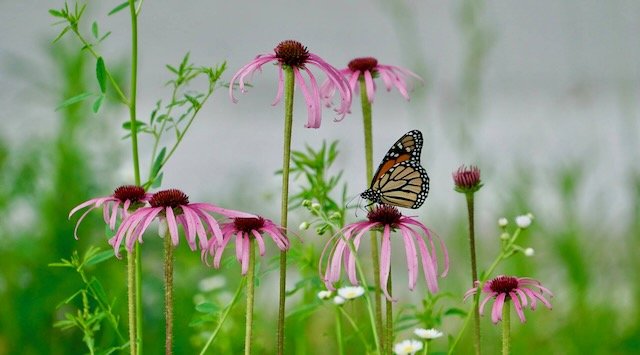This week is National Pollinators Week. In 2007 the US Dept. of Agriculture and the US Dept. of the Interior set aside this week to celebrate pollinators and spread the word about what each of us can do to protect them.
Pollinators are a vital part of a healthy environment. They convey pollen to fertilize flowers that produce fruit and seed. Bees are the main pollinators and the US has 4000 species of native bees. Native bees are ground or wood nesters, they are solitary, most do not sting and their average foraging distance is 50 feet to one-half mile. The most common bird that acts as a pollinator is the hummingbird. Other pollinators are bats, butterflies, moths, wasps, beetles, flies and ants.
More than 80 percent of the world's plants need pollinators. 75 percent of the world's flowering plants and 35 percent of the world's food crops depend on pollinators. The US grows more than 100 crops that need or benefit from pollinators. Some food items that we would not have if we lost our pollinators are apples, blueberries, strawberries, almonds, melons, peaches, pumpkins, tomatoes and citrus fruit.
There are two things each of us can do to help protect pollinators. First, reduce or eliminate the use of pesticides, and second, plant a variety of native plants with different bloom colors and shapes that flower at different times throughout the growing season.
A simple recipe for a pesticide substitute is a teaspoon of liquid dish soap in a gallon of water. Spray as needed on both sides of leaves to control aphids, spider mites and white flies.
Plants that provide pollen or nectar (or both) that bloom early in the Spring when food is scarce are especially helpful. Some examples of pollinator friendly shrubs and trees are dogwood, blueberry, cherry, plum, willow, oak, buttonbush, spicebush, serviceberry and New Jersey tea. Examples of native forbs are aster, beardtongue, bergamot, blazing star, cardinal flower, prairie clovers, compass plant, coneflowers, coreopsis, goat's rue, goldenrod, Indian paintbrush, indigo, leadplant, milkweed, mountain mint, poppy mallow, rosinweed, spiderwort, and sunflowers.
Planting host plants (food for the larva of pollinators) is also important to assure that pollinators successfully reproduce. Here are some examples of host plants for butterflies and moths.
· Common buckeye - blue toadflax
· Great spangled fritillary - violets
· Monarch - milkweeds and butterfly weeds
· Painted lady - pearly everlasting and sweet everlasting
· Red-spotted purple - cherries and willows
· Spicebush swallowtail - sassafras and spicebush
· Tiger swallowtail - basswood, birches, black cherry, tulip poplar and willows
· Zebra swallowtail - pawpaw
· Luna moth - alders, American beech, birches, hickories, maples, oaks, persimmon, sweetgum and willows
Pollinator Week has grown into an international celebration of the valuable ecosystem services provided by bees, birds, butterflies, bats and beetles. Wouldn't it be great if wildflowers lined all roadways and our vegetable gardens and agriculture fields had a border of native wildflowers?
We can all be a friend to pollinators.



